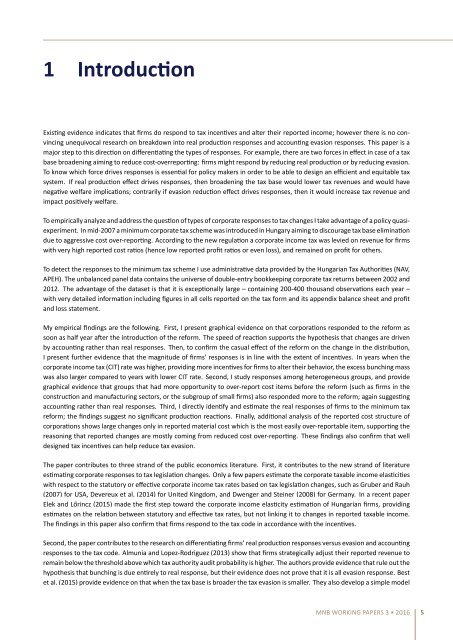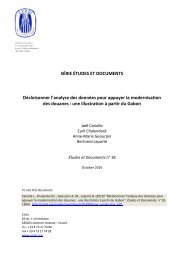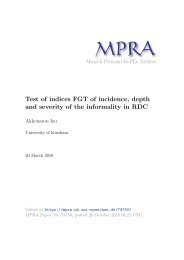Create successful ePaper yourself
Turn your PDF publications into a flip-book with our unique Google optimized e-Paper software.
1 Introducon<br />
Exisng <strong>evidence</strong> indicates that firms do respond to tax incenves and alter their reported income; however there is no convincing<br />
unequivocal research on breakdown into real producon responses and accounng evasion responses. This paper is a<br />
major step to this direcon on differenang the types of responses. For example, there are two forces in effect in case of a tax<br />
base broadening aiming to reduce cost-overreporng: firms might respond by reducing real producon or by reducing evasion.<br />
To know which force drives responses is essenal for policy makers in order to be able to design an efficient and equitable tax<br />
system. If real producon effect drives responses, then broadening the tax base would lower tax revenues and would have<br />
negave welfare implicaons; contrarily if evasion reducon effect drives responses, then it would increase tax revenue and<br />
impact posively welfare.<br />
To empirically analyze and address the queson of types of corporate responses to tax changes I take advantage of a policy quasiexperiment.<br />
In mid-2007 a minimum corporate tax scheme was introduced in <strong>Hungary</strong> aiming to discourage tax base eliminaon<br />
due to aggressive cost over-reporng. According to the new regulaon a corporate income tax was levied on revenue for firms<br />
with very high reported cost raos (hence low reported profit raos or even loss), and remained on profit for others.<br />
To detect the responses to the minimum tax scheme I use administrave data provided by the Hungarian Tax Authories (NAV,<br />
APEH). The unbalanced panel data contains the universe of double-entry bookkeeping corporate tax returns between 2002 and<br />
2012. The advantage of the dataset is that it is exceponally large – containing 200-400 thousand observaons each year –<br />
with very detailed informaon including figures in all cells reported on the tax form and its appendix balance sheet and profit<br />
and loss statement.<br />
My empirical findings are the following. First, I present graphical <strong>evidence</strong> on that corporaons responded to the reform as<br />
soon as half year aer the introducon of the reform. The speed of reacon supports the hypothesis that changes are driven<br />
by accounng rather than real responses. Then, to confirm the casual effect of the reform on the change in the distribuon,<br />
I present further <strong>evidence</strong> that the magnitude of firms’ responses is in line with the extent of incenves. In years when the<br />
corporate income tax (CIT) rate was higher, providing more incenves for firms to alter their behavior, the excess <strong>bunching</strong> mass<br />
was also larger compared to years with lower CIT rate. Second, I study responses among heterogeneous groups, and provide<br />
graphical <strong>evidence</strong> that groups that had more opportunity to over-report cost items before the reform (such as firms in the<br />
construcon and manufacturing sectors, or the subgroup of small firms) also responded more to the reform; again suggesng<br />
accounng rather than real responses. Third, I directly idenfy and esmate the real responses of firms to the minimum tax<br />
reform; the findings suggest no significant producon reacons. Finally, addional analysis of the reported cost structure of<br />
corporaons shows large changes only in reported material cost which is the most easily over-reportable item, supporng the<br />
reasoning that reported changes are mostly coming <strong>from</strong> reduced cost over-reporng. These findings also confirm that well<br />
designed tax incenves can help reduce tax evasion.<br />
The paper contributes to three strand of the public economics literature. First, it contributes to the new strand of literature<br />
esmang corporate responses to tax legislaon changes. Only a few papers esmate the corporate taxable income elascies<br />
with respect to the statutory or effecve corporate income tax rates based on tax legislaon changes, such as Gruber and Rauh<br />
(2007) for USA, Devereux et al. (2014) for United Kingdom, and Dwenger and Steiner (2008) for Germany. In a recent paper<br />
Elek and Lőrincz (2015) made the first step toward the corporate income elascity esmaon of Hungarian firms, providing<br />
esmates on the relaon between statutory and effecve tax rates, but not linking it to changes in reported taxable income.<br />
The findings in this paper also confirm that firms respond to the tax code in accordance with the incenves.<br />
Second, the paper contributes to the research on differenang firms’ real producon responses versus evasion and accounng<br />
responses to the tax code. Almunia and Lopez-Rodriguez (2013) show that firms strategically adjust their reported revenue to<br />
remain below the threshold above which tax authority audit probability is higher. The authors provide <strong>evidence</strong> that rule out the<br />
hypothesis that <strong>bunching</strong> is due enrely to real response, but their <strong>evidence</strong> does not prove that it is all evasion response. Best<br />
et al. (2015) provide <strong>evidence</strong> on that when the tax base is broader the tax evasion is smaller. They also develop a simple model<br />
MNB WORKING PAPERS 3 • 2016 5





